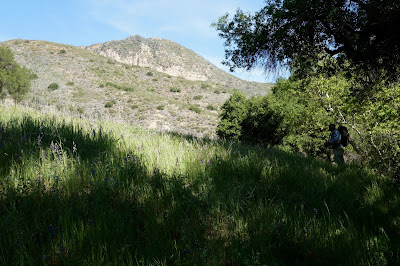Back in the drink with Jack Elliott. Once more we found ourselves waist deep in some backwater drainage (this seems to be a recurring theme). Our target this time was the upper reaches of Indian Creek. We were on the scout for waterfalls, a remote stretch of creek called Indian Narrows, and a long decommissioned campsite far up the canyon. This little foray turned into a really rough and rewarding overnight, the type of trip that I wished had lasted a couple days longer.
 |
| The Meadow, a junction of trails. |
My only experience with Indian Creek had ended one frozen, sleeting and sick-buddy December weekend. Ended precisely at Indian Creek Camp, and not one step further did we take. That was eight or nine years ago and I've always wanted to return, lured by the promise of waterfalls on a wild and remote drainage. Jack had been up IC that far and a bit further, but hadn't gotten as far as the fabled "Perfect Ten Falls" (per Conant's map). Clearly we needed to go see what that falls and an area called "The Narrows" was all about. And maybe we'd go see if we could find an old campsite that used to lie at the upper end of the IC Narrows.
 |
| Jack in Indian Canyon. |
Our weekend started with a strange animal sighting on the road down to Los Prietos. The headlights caught a glimpse of a fleeing canine, but this one seemed to big to be a fox and didn't look right to be a coyote. In the end Jack decided it must have been a large fox. I still insist that it was a rare North American Spiny Eared Chupacabra. Keep an eye out. Those chupacabrae are coming back in a big way.
We started from the Mono trailhead, wandering up the lower part of Indian Creek. The route took us through a mixture of brushy drainage and grassy hill country. Eventually we encountered a large meadow which is the junction for a couple trails. Continuing north we followed trail through oak forests and rocky creek bed until reaching a pretty camp sitting on a bench above the west side of the creek. There are a couple nice sites here under tall old oaks. One of the sites has a picnic bench and a few camp tools. This is Indian Creek Camp.
After a brief break at IC Camp Jack and I got going again, headed upstream into new territory for both of us. Within minutes of leaving IC Camp our use trail petered into the creek and it became obvious that it was time to get wet. Giving up on staying dry in such circumstances often makes the going so much easier. Even so, this is a rugged and overgrown drainage. Nothing about ascending this creek is particularly easy, though Jack and I have experienced worse.
After a couple hours of creek slogging and rock hopping we found ourselves approaching a distinctly narrow creek passage (below). Wading through a long and deep pool put us under a thirty foot cascade pouring from a beautiful pool and waterfall. After a short scramble up this falls put us at the deep upper pool, across from which streamed a very nice little waterfall. I initially called this Perfect 10 Falls but have since learned that this two-tiered falls is called the Maiden Pools (thanks for the correction, Brian).
 |
| Jack, approaching Maiden Pools. |
 |
| Upper Maiden Pools. |
We continued upstream from those falls, pushing ahead through pool after pool, scrambling over numerous creek obstacles. We found that poison oak and stinging nettles are prevalent in this drainage. Sadly, we weren't seeing much in the way of wildlife in this otherwise pristine aquatic wilderness. We saw a couple ducks, lizards, and a couple water snakes and turtles, but no big fish and no tracks of any larger mammals. I've been told that this pretty creek used to host some large and crafty land-locked native steelhead, and that those fish didn't fare too well in the aftermath of the 2007 Zaca Fire. Some good news I can report is that all the fire silt which was filling up the deep holes seems to have been flushed out.
Our upstream odyssey continued through the increasingly narrow and difficult drainage. This upper creek was challenging, a lot like work. We kept at it, wading, jumping, sloshing and climbing. The higher we ascended the prettier this drainage got, though "pretty" didn't make the journey any easier. We eventually approached a distinct narrowing in the canyon that correlated with what the maps call Indian Creek Narrows, or at least the lower gate of said narrows. From this gate on we'd be in a tight little canyon. A short time later we encountered what I thought was the best waterfall/swimming pool on the creek (below).
 |
| The lowest gate of Indian Creek Narrows. |
Leaving that pretty waterfall behind Jack and I continued our upstream progression. We eventually arrived at the confluence of a small branch canyon down which a poor stream emptied into Indian Creek. This then must be the long decommissioned Indian Narrows Camp. We climbed out of the creek to a small bench forested with oaks and scattered with the iron remains of this very old site. After a bit of R&R I tore down the remains of the fire ring, cleared out about four inches of oak leaves and set to work rebuilding the camp while Jack did a bit of looking around. By the time he returned the campsite sort of looked like it would work.
 |
| Indian Narrows Camp at our time of arrival. |
Firewood was abundant and as we set up shop for the evening we got some flames going to dry out our shoes. This was essentially a pointless exercise as we'd be getting back in the water immediately upon leaving in the morning, but it made me feel better to put on dry shoes for the evening. As the sun set and the light fell we were subjected to an enormous uproar of frogs, owls, and evening birds. We listened to the crescendo of frog calls while grilling filet mignon over the oak fire. The side dishes were sourdough with butter and baked beans with coffee. Not a bad menu after the day we'd slogged through.
We stayed up til around ten, feeding the fire and chatting about the day between lulls into silence. The evening was absolutely perfect and clear, warmish. I retired to my nest of leaves and stared up at the stars, tracked a couple satellites across the eastern sky. We both crashed out hard for the night, a night so dreamlessly perfect that I only used my bivy sack as a pillow. This was the type of outdoor night we always wish for but seldom get.
I rose shortly after sunlight and got the coffee going. We got ourselves put together in an unhurried fashion while enjoying the brew with a little breakfast. We rolled out at 8am and got back in the water right off the bat. We resumed our endless, sloshing, hopping river dance. The rest of it goes just that way. We did encounter a few people in the lower canyon, other waterfall hunters.
Like I said earlier, this was one of those little trips that I wish had lasted a bit longer, however the company was good, the route challenging and fun, and Indian Creek was a place I look forward to returning to.


















































